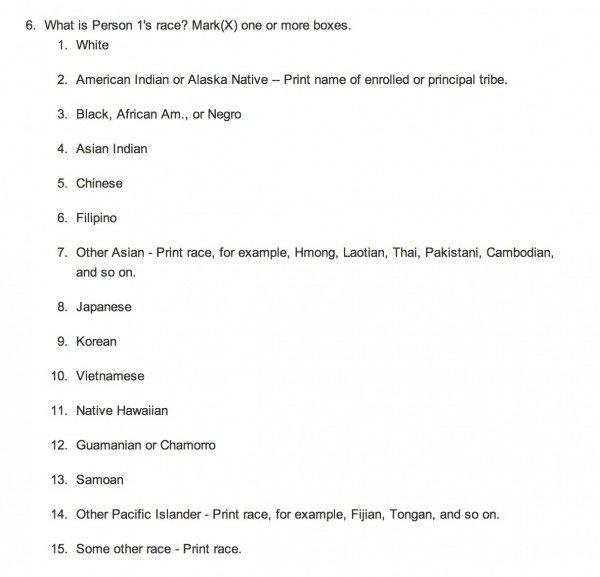Recently, a controversy about Latinos and racial classifications has led to heated debate based on a toxic mix of incomplete conclusions from research and rampant speculation.
A draft presentation at the Population Association of America (PAA) chronicled by a Pew Research senior writer was then picked up by Nate Cohn, writing for The New York Times’ “Upshot” blog. In the eyes of Cohn, his editor David Leonhardt and the Times, and based on a report that the scientific community has not seen or evaluated, Latinos were becoming “whiter.”
Surrounding all the controversy and discussion about reporting on research that was not available for inspection or review by other academics, two explanations to the tentative result from the unavailable census study have emerged: that the people changed (Cohn, Leonhardt and The Times) or that the census questions changed (Manuel Pastor in the HuffPost).
Cohn argues that the reported change reflects shifts in the people: a whitening indicative of Hispanic assimilation. Those that fear America becoming less white should be reassured that volunteers have been recruited and there are some wiling white Hispanics coming to the rescue. In making this argument, Cohn does not cite any studies or evidence to support his interpretations of research that has not circulated yet and, according to the authors of the study themselves, he has not seen.
Pastor argues persuasively that the different wording of the census question is likely to have led to the Blanqueamiento apparently found in the study highlighted by The Times and others who could and should invest the needed time and resources to know more about the Latino population.
In this short post, I will argue that the context in which the question is asked matters significantly for the answers given to racial classification questions. The census questions seem to assume that everyone is supposed to fit and agree with the way the categories are constructed and presented, and that whatever the census measures should be “stable” and “fixed over time.” It is quite possible that any changes in the census answers over time suggest challenges with the reliability and the validity of the race question itself (what it tries to measure and how it measures it) and the more fluid and contextual nature of racial classification for many populations.
Additionally, changes in the wording of the section and the question can also play an important role and can signal different reference points to the respondents (the difference between asking a Latino “what do you consider yourself to be” versus “what are you” and then asking that person to fit their identity into the North American racial classification schema).
Pastor makes a strong case that changes in the census question are potentially responsible for a lot of the apparent shifts that have been reported. Cohn also addressed this after his initial piece.
I tend to agree with Pastor: you can judge for yourself by examining the census questionnaire for 2000. The wording for questions 7 and 8 includes language about “what this person considers themselves to be.” Compare the 2000 questions to questions 8 and 9 of the 2010 census: “what this person considers themselves to be” becomes to “is this person.” In addition, the 2010 census states, “For this census, Hispanic origins are not races,” as noted by Pastor.
So, why is anyone surprised that a changing question with different reference points and wording generates different answers?
Again, we need to see the actual study from the PAA presentation to know what the authors themselves are arguing about the extent, nature and causes of the differences. However, for the purposes of highlighting a gross misrepresentation of Cohn’s first piece, we did a brief analysis of the 2012 (5-year) American Community Survey (ACS) for Puerto Ricans in New York City and the Puerto Rico community survey in Puerto Rico to illustrate how context matters for the answers that are given to U.S.-based racial classification schemas. This may also shed some light on the question of whether the people changed, as argued by Cohn, or whether changes in the census questions (as suggested by Pastor) are responsible for the fluidity in the use of the category.
My main argument is that in order to better understand where people fit in evolving racial classification schemas and the answers they give in census forms, we need to be able to disentangle between the potential role of any changes in the people (including conceptions of race, their racial attitudes and their experiences), the effects of changes in the question (the wording and instructions given that set a frame for respondents) and the impacts of any changes in the context in which the question is being asked and the potential reference points that are being used.
In the ACS, the “race” question asked in Puerto Rico is the same question asked in the mainland U.S. Comparing the answers given in Puerto Rico versus those given in New York City can help us understand the role of context, its potential impact on the answers and any potential individual level changes to those answers. The questions from the survey read:
The full data for this analysis can be accessed below.
Puerto Ricans Race Census Output by Latino Rebels
Comparing the answers for the same survey in the same year given in two different contexts for the Puerto Rican population leads to interesting results:
- In the 2012 (5-year) ACS, the percent of Puerto Ricans in New York City marking one race only is 94.5%, marking two 5.1% and marking three .3%. In Puerto Rico, the percent marking one race only was 88.4%, marking two 11.4%, and marking three 2%. This suggests that Puerto Ricans on the Island were slightly more likely to use more than one category in their answers.
- The percentage of Puerto Ricans in New York City choosing the “White” category was 44.7%. In Puerto Rico the percentage was 82.3%. This suggests that a much higher proportion of the Puerto Rican population in Puerto Rico used the “white” category.
- The percentage of Puerto Ricans in New York City using the “Black, African-America, or Negro” category was 12%. For those in Puerto Rico it was 18.7%. This suggests that a much higher proportion of the Puerto Rican population in Puerto Rico used the “Black, African American or Negro” category.
- The percentage of New York City Puerto Ricans marking “Some other race” was 47.3%. In Puerto Rico it was 10.1%. This suggests that a much higher proportion of the Puerto Rican population in New York City used the “Some other race” category.
- In terms of the broad race question as recoded by the census, comparing Puerto Ricans in New York with those living in Puerto Rico, the proportion that said “White only” was 41.5% in New York City and 70.9% in Puerto Rico; the percentage answering “Black or African American Alone” was 8.4 in New York City and 7.6% in Puerto Rico; the percentage using “some other race” was 43.6% in New York City and 9.5% in Puerto Rico; and the proportion with “two or more races” was 5.5% in New York City and almost double at 11.6% in Puerto Rico.
These significant differences in racial classification using the same question during the same period of time in the U.S. (New York City) and in Puerto Rico are not due to differences in the wording of the question because, like we said previously, the question asked is the same. That leaves us with two possibilities:
- First, that the racial composition of the Puerto Rican population in New York City is fundamentally different than the composition of the population in Puerto Rico. We have not seen any independent evidence or studies arguing this.
- A second possibility is that the context where the question is asked matters and that asking about race in Puerto Rico is different than asking the same population about their race in New York City. The question is not changing and the people are not changing—what is changing is the context, the reference point, the broader racial classification schema and categories that are used, how they are interpreted, their subjective meaning, and their social and sociological role.
Cohn further argues that the reported change in the answers given to the race question suggest Hispanic assimilation into the U.S. and into its racial classification schema. If anything, comparing data from Puerto Rico and Puerto Ricans in New York City suggests that mainland Puerto Ricans develop a sense of “otherness” as they come into closer contact with the U.S. racial classification regime. In fact, it would be interesting to compare the data from Puerto Rico with data from Puerto Ricans throughout the U.S. (not just New York City), those residing in various regions, as well as looking at the more recent arrivals to see if the categories they pick are different from Puerto Ricans that have been living on the mainland for a longer period of time.
Race is important, and racism and colorism are pernicious. They negatively impact the lives of many. As a biological concept, race is meaningless, but as a sociological concept it is extremely powerful. Since it is a sociological construction, however, race is a contextual and situational concept that can also be fluid and dynamic for many populations. People’s biological make-up does not change over time but their conceptions of themselves and where and how they fit in evolving racial classification schemas can be influenced by many factors and can change depending on context and reference point.
The recent debate over the meaning of racial categories and classifications has raised serious issues of validity and reliability with the question (and the amount of “noise” in the data) but, more importantly, it has also provided an opportunity to highlight the contextual nature of racial classification schemas. Asking a similar population the same question but in a different context, and with a potentially different reference point, has an impact on the answers.
I am glad there is more discussion and debate over the Latino population and, particularly, we need more discussions of issues of race, racism and colorism in the community and in the broader society. Immigrant Latinos bring their own conceptions and experiences of race into the U.S. while Latinos that have been in the U.S. for generations have had to navigate the complexities of racism and deal with the limitations and impacts of evolving racial constructions and classificatory schemas.
I’m looking forward to seeing the results from the census study once they are available. My hope is that the continuing debate on Latinos should be based on thoughtful data analysis and careful review of a broad and expansive literature and not speculation, presentations of unavailable research, misinformation, conjecture or preconceived notions.
***









[…] as Cordero-Guzman points out in a detailed discussion, referring to a post by Manuel Pastor, the Census questions changed between 2000 and 2010, with […]
[…] Professor Hector Cordero-Guzman brought attention to an important issue regarding the racial classification of Latinos in the U.S. […]
[…] When Latin American Racial Hierarchies Meet North American Racial Classification Schemas by Hector Cordero-Guzman […]
[…] When Latin American Racial Hierarchies Meet North American Racial Classification Schemas […]
[…] the past month, there has been an important discussion about Latinos and the racial classifications used by the U.S. census. I created this figure to add some additional narrative to explore how […]
[…] Cordero-Guzman also sends along this link and this one. […]